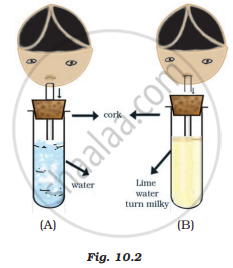Advertisements
Advertisements
प्रश्न
There are five animals P, Q, R, S and T. The animal P always lives in water and has gills for breathing. The animal Q can stay in water as well as on land and can breathe both, through moist skin and lungs. The animal R lives in soil and breathes only through its skin. The animal S lives on land and breathes through spiracles and tracheae. And animal T lives in water and breathes through its cell membrane.
(a) Which of the animals could be Amoeba?
(b) Which of the animals could be frog?
(c) Which animal could be fish?
(d) Which animal could be grasshopper?
(e) Which animal could be earthworm?
उत्तर
(a) T is Amoeba
(b) Q is frog
(c) P is fish
(d) S is grasshopper
(e) R is earthworm
APPEARS IN
संबंधित प्रश्न
List the differences between aerobic and anaerobic respiration.
If a plant is releasing carbon dioxide and taking in oxygen during the day, does it mean that there is no photosynthesis occurring? Justify your answer.
What is the name of the extensions of the epidermal cells of a root which help in respiration?
Out of photosynthesis and respiration in plants, which process occurs:
(a) all the time?
(b) only at daytime?
Fill in the Following Blank with Suitable Word.
_________ In the Lungs Provide a Very Large Surface Area for Gaseous Exchange.
Name the energy currency in the living organisms. When and where is it produced?
Which of the following increases in muscle cells when they are lacking in oxygen?
Lack of oxygen in muscles often leads to cramps in the legs of sprinters. This is due to the conversion of pyruvate to:
During the respiration of an organism A, 1 molecule of glucose produces 2 ATP molecules whereas in the respiration of another organism B, 1 molecule of glucose produces 38 ATP molecules.
(a) Which organism is undergoing aerobic respiration?
(b) Which organism is undergoing anaerobic respiration?
(c) Which type of organism, A or B, can convert glucose into alcohol?
(d) Name one organism which behaves like A.
(e) Name two organisms which behave like B.
It has been found that people living in very high mountains have many more red corpuscles in their blood than people living in plains. Which one of the following best accounts for this phenomenon?
Out of xylem and phloem, which one carries materials only upwards?
A student has set up "CO2 is released during respiration”. After about 1 hour he observes no change in the water level in the delivery tube. Write two possible resons for the failure of the experiment.
Which chemical compound inside a cell can be termed "Currency of Energy"?
Given below is an example of certain structure and its special functional activity:
"Kidney and excretion".
Fill in the blanks on a similar pattern.
Diaphragm and _____________.
Give suitable explanation for the following :
Why does a person feel breathlessness at higher altitudes?
The exchange of gases in the leaves takes place with the help of __________.
Observe Figure 10.2 carefully and answer the following questions.

- Which process is being tested in the activity?
- What is the result of the activity? Give reasons.
The oxygen dissociation curve is a sigmoid curve and it shifts towards the right due to ______.
